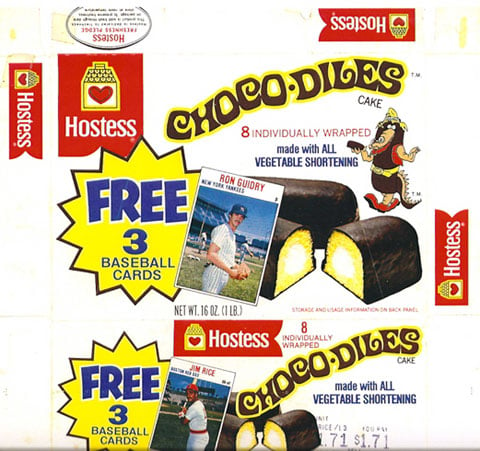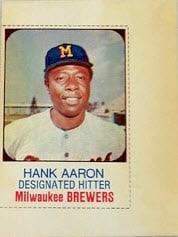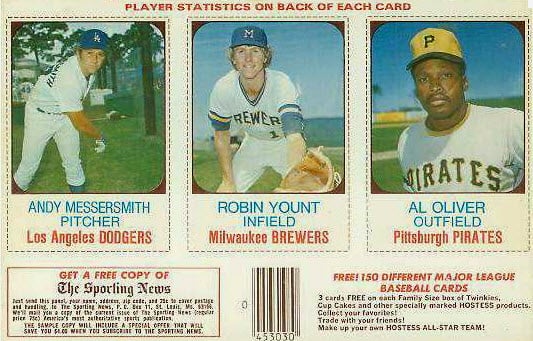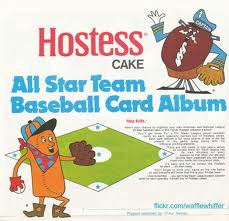Many of those who chuckled at the mad rush to buy Twinkies and Ding Dongs Friday don't remember the days when baseball card collectors rushed to outlet stores and grocery stores to buy them. From 1975-1979, if you had completed your Topps set, the Hostess baseball card sets were something new to chase. You couldn't order them from the company, either.
You had to work for them.
 Freezers of card collectors from Maine to Hawaii were stuffed with box after box of products. There were 150 cards to collect--50 panels in all and if you multiply that by $1.50 per box, you had a sizable investment. If you ate every box you opened, you also had a sizable waistline by the end of the summer if you weren't careful. If you were a kid, you were on a sugar high from May through September. No one really cared. The next delivery meant a new chance to search for cards or panels you needed.
Freezers of card collectors from Maine to Hawaii were stuffed with box after box of products. There were 150 cards to collect--50 panels in all and if you multiply that by $1.50 per box, you had a sizable investment. If you ate every box you opened, you also had a sizable waistline by the end of the summer if you weren't careful. If you were a kid, you were on a sugar high from May through September. No one really cared. The next delivery meant a new chance to search for cards or panels you needed.
If you lived near a bakery outlet, you got to know exactly when the unsold stock was put on the shelves. You knew that Wednesday was "bargain day" when the thrift stores marked them down to bring more traffic into the store and move product out before it was too old to stock anymore.
If you were a kid and had understanding parents, they were OK with buying multiple boxes and making Hostess the unofficial snack of the family's summer--the dessert you didn't have to bake. If you were an adult collector, you shook off the strange looks and asked perfect strangers who were buying boxes in the checkout line if they were going to save the cards on the back. Some were glad to dump the cakes out of the box and into their shopping bag and hand you the empty. Now that was collecting economically! Some even put flyers up in the stores, offering to buy the empty boxes for a buck or less and occasionally someone would respond.
Some cards were printed on less popular products and remain harder to find today. Those printed on the back of HoHos multi-pack boxes are often creased at the corners from handling. There simply wasn't much room to play with on the sides and cutting the panels from the boxes often resulted in small creases if they weren't already showing them on the store shelf.
Here's a look back at the five sets produced by the late, great Hostess Company:
1975
 Collectors who remember the debut of Hostess baseball cards remember the rush when you first saw the little ads next to the display. First out were the individual cards that served as the backing for individual Twinkie packages. At 25 cents each, you could now have a snack AND a Hank Aaron card. The beauty of this new addition to collecting was that you could see who you were buying. The cards were face up on the back and you could easily buy the card you needed. Hank Aaron had been traded from Atlanta to Milwaukee and his airbrushed Brewers cap adorned the top of his head. There was a greasy vertical smear from the Twinkies soaked through front and back which was a bit of a bummer, but they were cheap.
Collectors who remember the debut of Hostess baseball cards remember the rush when you first saw the little ads next to the display. First out were the individual cards that served as the backing for individual Twinkie packages. At 25 cents each, you could now have a snack AND a Hank Aaron card. The beauty of this new addition to collecting was that you could see who you were buying. The cards were face up on the back and you could easily buy the card you needed. Hank Aaron had been traded from Atlanta to Milwaukee and his airbrushed Brewers cap adorned the top of his head. There was a greasy vertical smear from the Twinkies soaked through front and back which was a bit of a bummer, but they were cheap.
 There were 60 cards in the individual Twinkies set, it turned out. #1-36 and then skip numbered to 150. It was confusing but collecting was starting to become a little more mainstream and information traveled relatively fast.
There were 60 cards in the individual Twinkies set, it turned out. #1-36 and then skip numbered to 150. It was confusing but collecting was starting to become a little more mainstream and information traveled relatively fast.
Soon, it was also evident that you could buy stain-free cards if you could spring for an entire box of Twinkies, HoHos, Ding Dongs (or King Dons as they were labeled in some areas), Cupcakes and Suzy Q's. Some cut them into individual cards as invited by the dotted lines but the smarter set cut them into panels. Down the road, they'd be worth more. There was a small ad for a free copy of The Sporting News just below the back panel.
The 1975 set was full of errors. Burt Hooten's name was spelled "Bert" in the first printing.  Doug Rader turned into Doug "Radar" at first. George Hendrick was George "Hendricks". Jim Sundberg was called Mike and those two errors were never fixed. It was pretty obvious whomever set them up for printing didn't know a lot about baseball. Bill Madlock was one of the game's best hitters but Hostess identified him as a pitcher early on. Both cards are worth about the same, just like the other errors, since there were about as many corrected versions printed as errors.
Doug Rader turned into Doug "Radar" at first. George Hendrick was George "Hendricks". Jim Sundberg was called Mike and those two errors were never fixed. It was pretty obvious whomever set them up for printing didn't know a lot about baseball. Bill Madlock was one of the game's best hitters but Hostess identified him as a pitcher early on. Both cards are worth about the same, just like the other errors, since there were about as many corrected versions printed as errors.
Hostess did have the foresight to put a teenage shortstop for the Milwaukee Brewers in the set. Robin Yount's card is now one of the more valuable, although massive quantities of never used boxes featuring Yount and several others eventually made their way into the hobby. Sadly, there's no George Brett. There is a Nolan Ryan who was in his California Angels prime at the time.
The 1975 Hostess panel set is worth around $300-400, depending on condition. The single card set varies wildly because of the stain issue and whether the cards were cut from the back panel.
1976
 It was the bi-centennial year and Hostess returned in the summer of '76 with new sets done in a red, white and blue theme. As was the case in all five years, the backs consisted simply of the player's name and vital info along with season and career totals.
It was the bi-centennial year and Hostess returned in the summer of '76 with new sets done in a red, white and blue theme. As was the case in all five years, the backs consisted simply of the player's name and vital info along with season and career totals.
If you collected the 1976 Topps set, you'll recognize some of the photos in the Hostess set are the same. The set is loaded with stars. Brett was included this time along with Ryan, Pete Rose, Mike Schmidt, a Dennis Eckersley rookie and one last card of Aaron, who was in his final season.
Collectors had a hard time finding some of the panels that were printed on less popular products and today, those 'single prints' command a premium.
Hostess again put single cards into Twinkie packages but they were harder to find than in 1975. This time the 60-card set mirrored the players in the multi-pack boxes, #1-60.
A full set in panel form is worth around $350.
1977
 The first three panels issued in the 1977 Hostess baseball set packed major star power. Jim Palmer, Joe Morgan and Reggie Jackson opened things up, followed by Carl Yastrzemski, Thurman Munson and Johnny Bench. #7, 8 and 9 were Tom Seaver, Pete Rose and Rod Carew. Hostess gave us another Ryan card. Yount returned, too.
The first three panels issued in the 1977 Hostess baseball set packed major star power. Jim Palmer, Joe Morgan and Reggie Jackson opened things up, followed by Carl Yastrzemski, Thurman Munson and Johnny Bench. #7, 8 and 9 were Tom Seaver, Pete Rose and Rod Carew. Hostess gave us another Ryan card. Yount returned, too.
By this time, most collectors were saving them in complete panels. The 1977 single card Hostess set jumped from 60 cards to 150 but was issued on a very limited basis. This time, they were also included on backs of cupcakes, meaning a slightly smaller size.
Hostess also produced a collector's album for the set, available as a mail-in offer.
Complete panel sets run $200-300 on average with the single card sets selling for two or three times that amount because of scarcity.
The Eddie Murray Hostess rookie card highlighted the fourth set of Hostess cards, although few at the time were ready to label him a future Hall of Famer. He shares a panel with Gary Lavelle and Rennie Stennett and you can expect to pay $30-40 or more for one, about the same as the Nolan Ryan panel. '78 Hostess were pretty plain from a design perspective and included some action shots. This time, no individual Twinkie or Cupcake packs carried cards. Panel sets today are worth around $275.
1979
Apparently the effectiveness of using baseball cards as a marketing tool had worn off or become too expensive but '79 was the swan song for Hostess panels. 
Again, Hostess was smart enough to print a card of a young Ozzie Smith with its set and they put him on the same panel with Nolan Ryan making it the most valuable of all individual Hostess panels issued from 1975-79 at about $60 (and you'll also get Willie Montanez...whoo hoo!). Expect to pay $60 or more for a nice, graded one but remarkably, you can buy a pretty decent ungraded example for $20 or less. A high q uality Smith-Ryan panel might be one of the most underrated cards of the '70s. The number of panels compared to the number of Topps Ozzie rookies is miniscule.
uality Smith-Ryan panel might be one of the most underrated cards of the '70s. The number of panels compared to the number of Topps Ozzie rookies is miniscule.
Complete Hostess panel sets from 1979 have a book value of around $300.
There were unissued proof cards made for the last four Hostess sets. They are extremely rare and include players who do not appear on the snack cake boxes. Most are middle of the road or common players but in '76, the Steve Carlton is worth about $100 and the Fergie Jenkins around $75. In '79, Willie McCovey and Alan Trammell proofs are the most valuable.
On an average day, around 3,000 Hostess cards from the 1970s can be found on eBay ranging from complete boxes to single cards to panels, some of which have been professionally graded (yes, PSA does grade them). Click here to see what's up for bid now.
